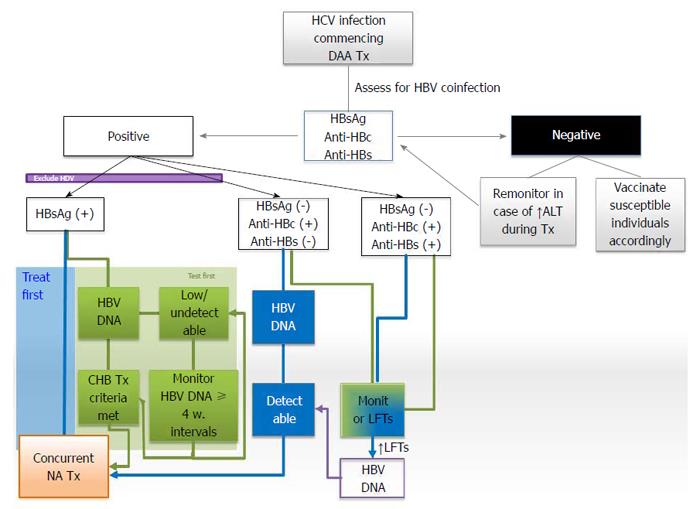Copyright
©The Author(s) 2017.
World J Gastroenterol. Jun 28, 2017; 23(24): 4317-4323
Published online Jun 28, 2017. doi: 10.3748/wjg.v23.i24.4317
Published online Jun 28, 2017. doi: 10.3748/wjg.v23.i24.4317
Figure 1 Treatment algorithm.
Therapeutic options for HCV-HBV co-infected patients. All HCV patients who are about to commence DAA therapy should be assessed for HBV coinfection and accordingly for HDV. Patients who are negative for HBV will be monitored using liver function tests (LFTs) during and after the end of DAA therapy. A flare in ALT/liver biochemistry during this timeframe should prompt the treating physician to reconsider the possibility of an occult HBV infection and to re-test for HBV infection (HBsAg and/or HBV DNA)[36]. Management options for patients who are positive for HBV vary according to their serology results. HBsAg positive patients have the following two options: the “treat first” approach (blue pathway), where HBsAg positive are treated with NA agents (commencing NA therapy even before the start of DAA treatment), or the “test first” option (green pathway) where patients are monitored with HBV DNA and are treated according to the detected levels. Both treatment options are viable and are supported by clinical guidelines[36,37]. HCV: Hepatitis C virus; HBV: Hepatitis B virus; DAA: Direct-acting antiviral; Tx: Therapy; HDV: Hepatitis D virus; CHB: Chronic hepatitis B infection; HBsAg: Hepatitis B surface antigen; anti-HBs: Hepatitis B surface antibody; anti-HBc: Total hepatitis B core antibody; NA: Nucleoside/nucleotide analogue; LFTs: Liver function tests; ALT: Alanine transaminase. Blue pathway, options in accordance with EASL guidelines; green pathway, options in accordance with AASLD - IDSA guidelines.
- Citation: Aggeletopoulou I, Konstantakis C, Manolakopoulos S, Triantos C. Risk of hepatitis B reactivation in patients treated with direct-acting antivirals for hepatitis C. World J Gastroenterol 2017; 23(24): 4317-4323
- URL: https://www.wjgnet.com/1007-9327/full/v23/i24/4317.htm
- DOI: https://dx.doi.org/10.3748/wjg.v23.i24.4317









